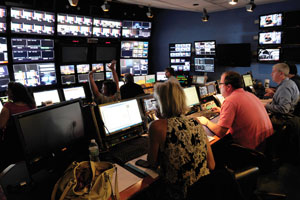Trading up: CBS Sports Network's studio upgrade
CBS Sports Network, the cable home of CBS Sports, had outgrown its studio. Built in 2003 for CSTV: College Sports Television, a cable start-up featuring college sports, CBS Sports Network’s Chelsea Piers studio in New York City was in need of an update.
The upgrade began in 2010 with the network’s transition from standard- to high-definition. It continued this summer with the goal of revitalizing and upgrading the network’s on-camera look with a new set, as well as expanded graphics and transmission areas to accommodate the growing network’s needs.
When setting out to design and build a new studio, network executives had to take into account not only the dozens of studio shows and original programs produced out of the facility, but the more than 350 live games produced by the network each year.
Project planning
Patty Power, senior vice president of operations, and Kelly Dunne, senior vice president of marketing and creative services, led the group in designing the new set, along with a design team from Jack Morton Worldwide. The group wanted to make better use of the 6,000sq-ft stage occupied at CBS Sports Network, only half of which was utilized by the old set. Another goal was to raise the grid, which had been rather low despite the studio’s 20ft ceilings. Having more technology visible throughout the set was a priority, as the team sought a more modern look.
Power and Dunne also worked with chief technical officer Walter Raps and Tyler Hale, vice president, studio production, to identify an operations and production workflow — one that allowed the creation of a state-of-the-art, cost-effective facility that could be completed in a tight time frame. While planning for the process began over a year prior, actual renovation could not begin until after the NCAA Division I Men’s Basketball Championship in April. It then needed to be completed before college football season in August.
Technical facilities
After the design and technical requirements were clear, Richard Hart, vice president, entertainment production and technical operation, CBS, ensured that construction and installation were implemented by the CBS Scenery Shop. This group has been involved in all major productions constructed at CBS for more than 50 years. Most recently, it has been involved with the fabrication of “CBS This Morning,” WCBS local news, “Anderson Live,” CBS Sports and “CBS Evening News.” Projects are fabricated through the direction of shop head David Tasso and his team, including shop foreman Tom Bianco and project engineer Pat O’Donnell. Head electrician Joseph Bradley and charge scenic artist Mark Prouse created the intricate lighting, paint and graphics.
Get the TV Tech Newsletter
The professional video industry's #1 source for news, trends and product and tech information. Sign up below.
Project engineer Patrick O’Donnell took on implementing the design and working closely with Marianne Fischer and Raps to construct the production space. Fabricating the unique set that boasts layers of monitors, metallic details, custom LED light fixtures, oversized ceiling units and an immense anchor desk was challenging. After the fabrication process was completed in their facility, Bianco then oversaw the installation.

Nearly 50 new LCD monitors, including a mix of 32in, 46in, 60in and 85in displays, help the CBS Sports Network staff produce shows and more than 350 live games each year.
Raps and his team oversaw the installation of nearly 50 LCD monitors — a mix of 60in Sharp, 46in NEC, 32in NEC and 85in Panasonic displays, all fed from three Evertz 3000 DVT video wall processors. The system was configured with 18 shared inputs and 54 outputs, as well as a Dataton WATCHOUT multi-display production and playback system with eight outputs. An LED screen from Tally Display, similar to those used at stadiums, also was installed in the set’s floor, allowing the creative team to simulate fields and courts. Both the videowall and floor screens can be fed from any video source on the facilities’ Miranda hybrid router or Sony MVS8000X video switcher, which pass through Cobalt’s 9084 RGB color corrector for final adjustments.
Updates also included a SAN upgrade, which increased proxy storage by about 58 percent and main storage used for high-res video by about 55 percent. The Data Direct Network is about 300TB for high-res and 120TB for proxies. Archival software uses ASG’s Atempo with some custom written modules, utilizing the network’s existing SpectraLogic T120 robot. Transmission was moved to a larger space, allowing for future growth. IP connection was enhanced between the Chelsea Piers facilities and CBS television network broadcast center about 2.5mi away, which will allow additional feeds to and from the center. In all, the team re-wired more than 10mi of studio wiring, including Belden 1505A, 1694A and 1805A cabling.
In addition to transmission, all studio and remote graphics operations were relocated to a larger, self-contained location with room for growth and enhanced quality control. Blackmagic Design routers were added to existing Miranda multiviewer feeds to user monitors so they can be easily switched out depending on show requirements. Custom furniture from Impulse Design was also added, as was further integration with CBS Information Technology and CBS Interactive for score and statistics feeds.
Studio C and Control Room C, where the “Tim Brando Show” is produced daily, were relocated to allow for the larger main set. Also, audio and video ties were increased, and the integration with the main control rooms also was enhanced.
Other upgrades included five Sony HSC300K multiformat camera systems, hardware upgrades for the two EVS XT2 systems, several Kaleido-X multiviewers and the Miranda NV8576 hybrid router.
The control room features a Sony MVS8000X with 80 inputs, four ME and four DME channels, as well as a Calrec Omega 56 fader 5.1 capable digital audio console. Production capabilities include a 2x Orad PlayMaker, 2x EVS XT2, 12 Sony XDCAM PDW-HD1500 recorders and 24 channels of live XDCAM format ingests using Primestream’s FORK production suite.
Technology at work
- ASG Atempo: archival software Belden: 1505A, 1694A and 1805A cabling
- Blackmagic Design: routers
- Calrec: Omega digital audio console Cobalt Digital: 9084 RGB color corrector
- Data Direct Network: storage with 300TB for hi-res and 120TB for proxies
- Dataton: WATCHOUT multi-display production and playback system
- Evertz: 3000DVT video wall processors
- EVS: XT2 servers
- Impulse Design: custom furniture
- Miranda: Kaleido-X multiviewers, NV8576 hybrid router
- NEC: 32in and 46in monitors
- Orad: PlayMaker HD/SD slow-motion server
- Panasonic: 85in display
- Primestream: FORK production suite
- Sharp: 60in monitor
- Sony: HSC300K multiformat cameras, MVS8000X production switcher and XDCAM PDW-HD1500 recorders
- SpectraLogic: T120 robot library
- Talley Display: LED screen
Project team:
- CBS Sports Network: Patty Power, senior vice president, operations; Kelly Dunne, senior vice president, CBS Sports marketing; Tyler Hale, vice president, studio production; Walter Raps, chief technical officer; Marianne Fischer, vice president, studio operations; Demetra Marcus, vice president, marketing
- CBS Scenic Shop: Richard Hart, vice president, entertainment production and technical operation; David Tasso, shop head; Tom Bianco, shop foreman; Pat O’Donnell, project engineer; Joseph Bradley, head electrician; Mark Prouse, head scenic artist
- Installation Technicians: Jim Parkinson, timeframe productions, system engineering & integration; Mike Steinhart, director, broadcast technology solutions; Jonathan Handler, broadcast post production engineer; Thomas O. Carroll, Jr., installation technician; Mike Moutopoulos, installation technician; Ryan Breen, installation technician; Doug Terpsa, installation assistant
- Jack Morton Worldwide: Juliann Elliott, associate designer; Andri Durette, senior design director
—Mariel Brady is junior publicist, CBS Sports Network.
